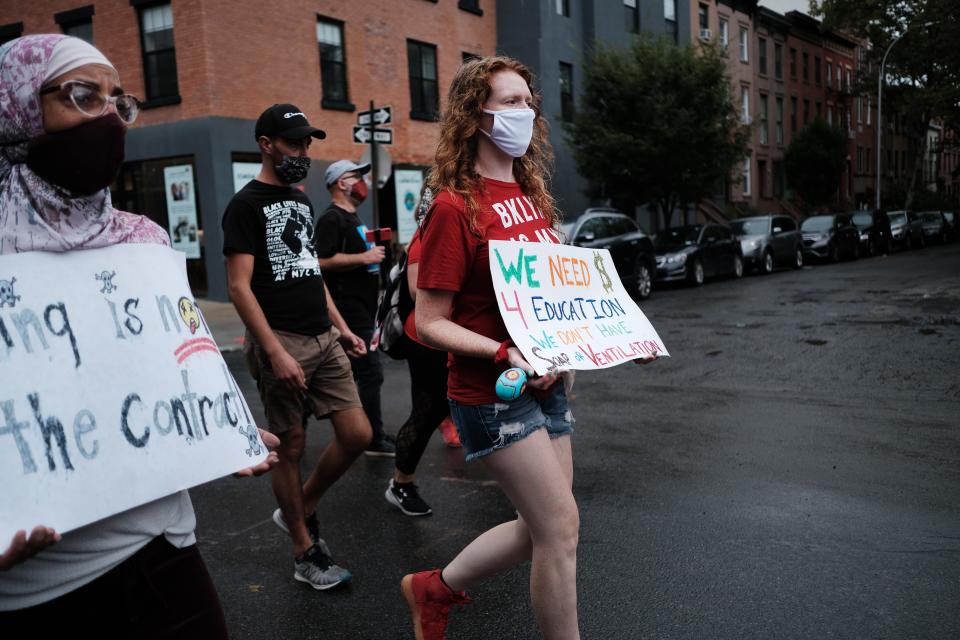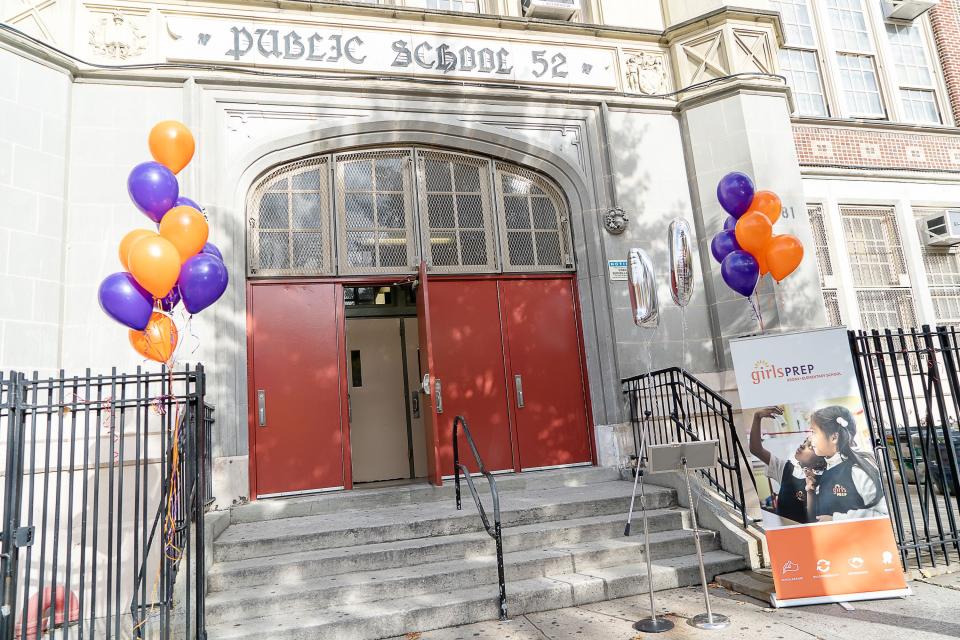Facing Monday deadline, New York City will again delay start of in-person classes
Burdened by staffing shortages, building ventilation issues and last-minute changes to instructional plans, New York City's schools will delay bringing back students for in-person instruction — again.
Now, students attending school with a mix of in-person and at-home learning will return to their buildings in phases: Monday for special education and pre-kindergarten students, Sept. 29 for elementary students and Oct. 1 for middle and high school students, the United Federation of Teachers confirmed Thursday.
About 42% of New York children have elected to learn from home full-time, a number that's increased from 37% in the two weeks since Mayor Bill de Blasio and the city's teachers union reached the original deal to push back the start of school, from Sept. 10 to Monday.
The chaotic situation has demonstrated just how hard it is to reopen urban school systems during a pandemic. Among the 20 largest school systems in the U.S., only New York and Hawaii elected to start the year with in-person learning, and Hawaii is a statewide school system with buildings spread out across its islands.
Among the 100 largest districts in the country, 73% launched the year with a return to fully remote learning, according to Education Week magazine.
Mayor Bill de Blasio believed New York City could be different after recovering from more than 20,000 virus-related deaths in the spring to now posting infection rates that are well under the nationally recommended threshold to reopen school buildings. He said this week that New York City would set the gold standard for health and safety in schools.
But school staff and the teachers union had issued steady complaints that buildings were not ready.
Dan Gannon, a teacher at Bronx Leadership Academy II, said he returned to his building earlier this week to find it hadn't been cleaned.
Vivett Dukes, a high school English teacher at School of the Future in Manhattan and a delegate of the National Parents Union, a grassroots group that represents many parents of color, said she wasn't surprised by the mayor calling for another delay.
"All remote from the beginning was the way to go," she said. "This could have been avoided."
Harbinger for other urban districts?
Other districts that chose to start school remotely because of safety concerns have been watching to see how New York City, with more than 1.1 million public-school students, pulls off an in-person start.
But as the deadline loomed to reopen schools Monday, the challenges multiplied. Some New York City teachers who returned to work set up their laptops outside their schools in recent days to protest what they believed were unsafe working conditions inside.
As of late as Tuesday — less than a week before the reopening — the city announced significant changes to its instructional guidance for teaching students on the blended model, which includes coming to school one to three days a week and learning from home on the other days. De Blasio had wanted blended-model students to receive live, virtual lessons on the days they learn from home. Now, schools will no longer have to provide that. Remote learners will still receive live, daily lessons.
Coronavirus and schools: With COVID-19 complicating enrollment counts, public schools brace for impact on funding
Schools did not have enough teachers for in-person learning if all buildings were to open Monday, Mark Cannizzaro, president of the School Supervisors & Administrators Council, said in a statement this week.
He said they estimated the city needed 10,000 more educators. On Monday, de Blasio announced he would deploy another 2,000 certified educators from the Department of Education to assist.
Then, Thursday morning, de Blasio told the teachers union he would get them another 2,500 educators on top of that.
"There’s still problems with some supplies, there’s still problems with ventilation," Michael Mulgrew, president of the United Federation of Teachers, said in a news conference before the additional delay to the start of school was announced.
He added there's been a two- to three-day lag from when the union hears about a case of COVID-19 in schools or among educators and when the Department of Education confirms it.
'Not a sustainable model': A peek at how one high school handles its COVID-19 challenges
"I want New York City schools to be open, but they can only be open if everything is in place," Mulgrew said.
Since staff returned to work in their schools, 17,000 school-based employees have been tested, and 55 tested positive for the virus, a rate of 0.3%, de Blasio said this week.
"Some students will test positive at some point in the year, and they'll go home for two weeks and then they'll come back and they'll complete the school year," he said.
"We have to remember that for the very small percentage of people who test positive for the coronavirus, it is a very temporary reality."

Urban districts' unique challenges
Densely populated urban school districts face particular challenges when it comes to weighing the risk vs. reward of reopening buildings.
Urban school buildings are often older and more cramped than those in suburban or rural districts, and class sizes in big cities tend to skew larger. That raises questions about providing adequate ventilation and physical distancing to limit the spread of the new coronavirus. Also, most urban districts serve large numbers of students who are low-income and/or racial minorities — the very populations that have been disproportionately affected by COVID-19.
Just this week, new federal statistics showed that only 121 people under the age of 21 died of the virus in the U.S. between February and July, but that most of the children and young adults who died were either Latino or Black.
COVID-19 and schools: As schools shift to online learning, what should they do about cyberattacks?
De Blasio has positioned reopening schools as an urgent social justice issue, noting that children facing economic disadvantage are the most likely to have fallen behind during the abrupt shift to virtual learning this spring. Many lacked a personal computer or internet access to complete online lessons. Some lacked a quiet place to study, or adults who could aid their learning at home.
While parents and educators agree with the need to reopen schools, many worry that a premature return to crowded indoor spaces could spark a new outbreak.
Tanya St. Julien, a member of Community Education Council 16 in Bedford-Stuyvesant — a Brooklyn neighborhood that had one of the highest rates of COVID-19 infections — said most families eventually want their children learning in school again with their peers.
But, she said, families are concerned that coming into school buildings without proper ventilation, appropriate health-care staffing and clear protocols for health and safety will increase the risk of contracting the virus.
COVID-19 and schools: Summer parties, teacher shortages push suburban schools to scrap reopening plans
"We are concerned about being in buildings," she said.
She said parents have also been contused because of constantly shifting information.
As part of the agreement reached between the mayor and the teachers' union reached to delay the start of school the first time, the union was allowed to inspect each school building for safety.
Union officials wouldn't tell USA TODAY this week what percentage of buildings it still considered unsafe.

'This could be death'
Early this summer, leaders from many school districts around the country expected to return to in-person instruction in the fall. But as positive cases spiked, most metropolitan school systems pivoted to planning for a remote start.
Chicago Public Schools held out longer than most large districts — its leaders initially proposed a plan to start the year with in-person instruction. After the Chicago Teachers Union started murmuring about a strike for educators' safety, Chicago Mayor Lori Lightfoot announced the district would start with all children learning remotely, citing a growing number of infections and parents signaling they wanted their children to learn from home.
Chicago Teachers Union President Jesse Sharkey said if the mayor and school system had focused on remote learning sooner, they could have spent more time during the summer making remote learning more robust, accessible and enriching.
"There is no question that CTU members and families are safer learning at home," Sharkey said in a statement to USA TODAY.
Back in New York, Brendis Gonzalez, a fourth-grade teacher at Washington Heights Expeditionary Learning School in Manhattan, said she didn't feel it was safe to welcome back students yet. The fact that at least 55 education staff have contracted the virus since returning to work after Labor Day concerns her, even though that infection rate represents less than 1% of the workers at the time.
The personal protective equipment her school was promised arrived a week late, she said.
"Think about how much PPE has cost a large city like New York to have this idea of blended learning," she said.
She wished that money had been spent on improving remote learning and that school officials would have stuck to a timeline to launch the year.
Dukes, the teacher at School of the Future, received a medical accommodation to teach from home. But she's not sure if parents are getting all the information they need from the Department of Education to make the right decisions for their families.
"This could be like catching a cold — or it could be death," she said. "You don't know how the virus is going to hit you. What are we willing to risk to find out? Our lives? Our children's lives?"

Many charters going virtual
Many of New York's charter schools, which are privately run public schools that operate independent of the Department of Education, have already started the year with a return to remote learning. Close to 136,000 students attend charter schools in New York, which is about 13% of the public-school student population.
Public Prep, a network of five New York charter schools serving about 2,100 students, launched the school year on Aug. 25 with all children learning from home, first on a half-day schedule, then on a full-day schedule.
CEO Janelle Bradshaw said they concentrated on making sure all students, about 85% of whom are low-income, had devices and internet before the year started. The network has contracts with internet providers to get Wi-Fi to families, she said.
In early October, depending on health conditions, Public Prep plans to start offering in-person instruction as well. So far, 45% of families say they want that option; 55% have signaled they wish to stay remote, Bradshaw said.
The phased-in approach has allowed the network to plan ahead, and teachers are mirroring school culture and maintaining high standards as best they can through screens, Bradshaw said.
But everyone looks forward to children coming back to classrooms.
"While we have made the best of remote learning, it is not the best way for all children to learn," Bradshaw said.
Contact Erin Richards at (414) 207-3145 or erin.richards@usatoday.com. Follow her on Twitter at @emrichards.
Education coverage at USA TODAY is made possible in part by a grant from the Bill & Melinda Gates Foundation. The Gates Foundation does not provide editorial input.
This article originally appeared on USA TODAY: Facing Monday deadline, NYC will again delay start of in-person classes


